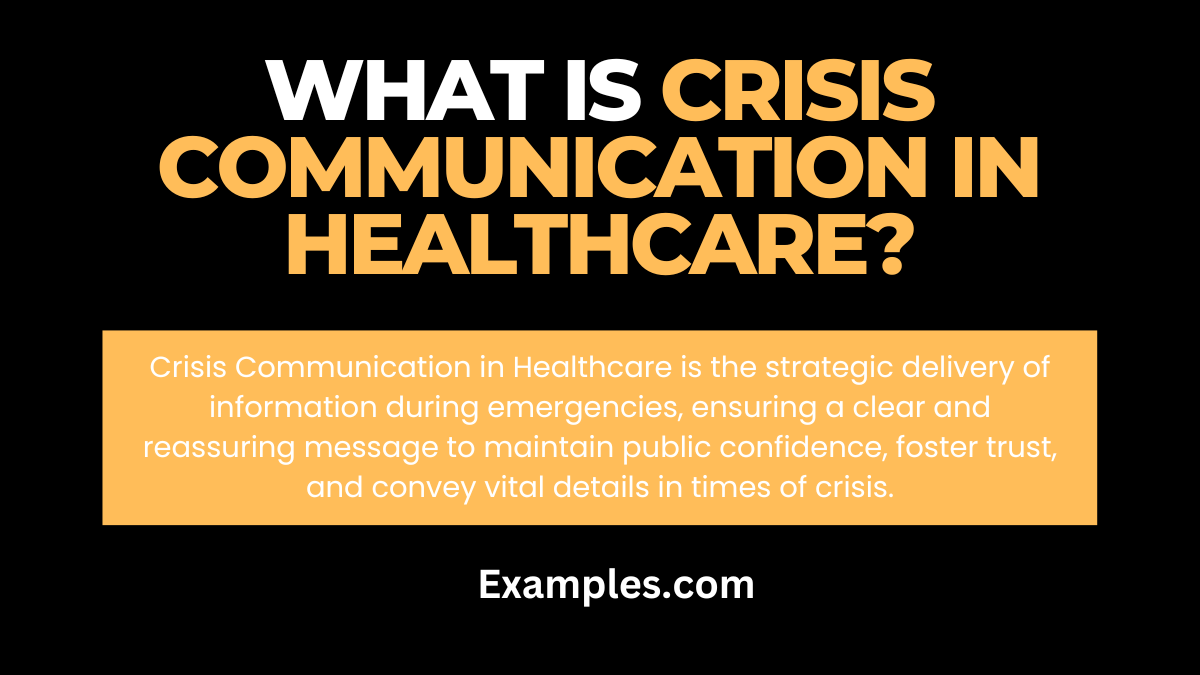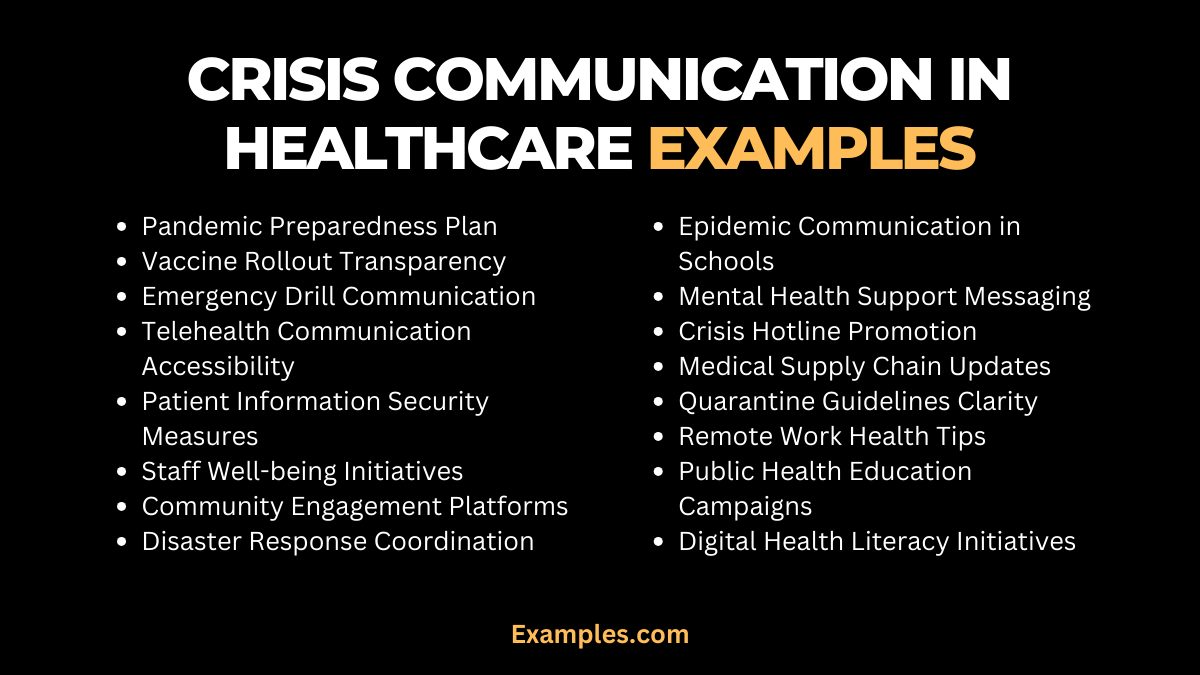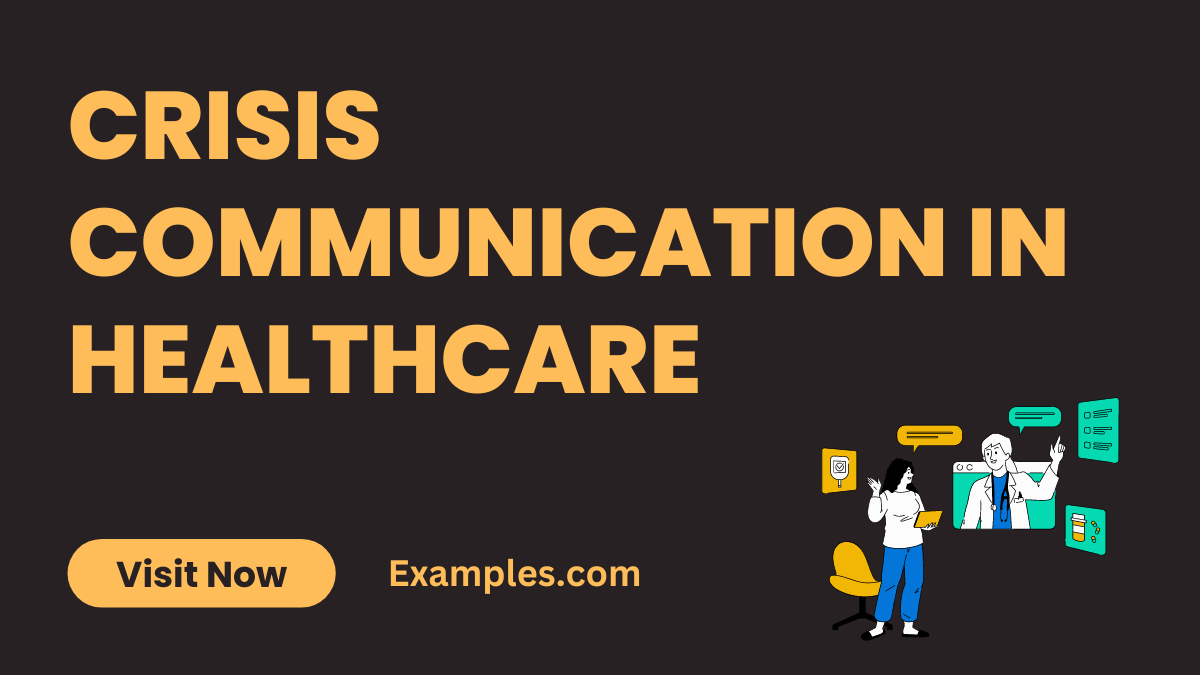19+ Crisis Communication in Healthcare Examples
Unlock the keys to effective Crisis Communication in Healthcare with our comprehensive guide. Navigating through real-world scenarios, this guide not only equips you with essential tips but also delves into impactful Communication Examples. From crisis management strategies to practical insights, this resource ensures you’re well-prepared. Dive into the world of healthcare crisis communication and discover the power of proactive strategies alongside illustrative examples. Elevate your response game to safeguard your healthcare institution in critical times.
What is Crisis Communication in Healthcare?

Crisis Communication in Healthcare refers to the strategic dissemination of information during emergencies to ensure a clear, concise, and reassuring message. In simple terms, it’s how healthcare institutions communicate vital details in times of crisis. This approach involves not only conveying facts but also fostering trust and understanding. Navigating through uncertainties, this process is crucial for maintaining public confidence. Discover the core meaning and definition of Crisis Communication in Healthcare, simplifying its importance for everyone.
What is the Best Example of Crisis Communication in Healthcare?

In the realm of Crisis Communication in Healthcare, one outstanding example is the response to the 2014 Ebola outbreak. Swift and transparent communication from health authorities played a pivotal role in managing the crisis. From timely updates to clear guidelines, the approach focused on disseminating accurate information to curb misinformation. This case study underscores the significance of proactive communication, demonstrating how a well-handled crisis response can mitigate panic and guide communities towards informed actions.
20 Crisis Communication in Healthcare Examples

In the dynamic landscape of healthcare, effective Crisis Communication is paramount. Explore various real-world Crisis Communication in Healthcare examples to understand strategies for navigating uncertainties and ensuring public confidence.
- Pandemic Preparedness Plan: Devise a clear plan guiding communities through uncertainties. Example: Communicate preventive measures for widespread understanding.
- Vaccine Rollout Transparency: Enhance trust with transparent vaccine distribution updates. Example: Share real-time information on vaccine availability.
- Emergency Drill Communication: Streamline crisis responses through regular communication drills. Example: Practice protocols to ensure staff readiness.
- Telehealth Communication Accessibility: Expand healthcare reach with clear telehealth communication. Example: Communicate user-friendly telehealth services.
- Patient Information Security Measures: Build trust with robust data protection communication. Example: Ensure patient confidentiality through secure information handling.
- Staff Well-being Initiatives: Foster a supportive environment with staff well-being communication. Example: Communicate support programs for enhanced staff resilience.
- Community Engagement Platforms: Utilize social media for updates and community participation. Example: Engage through interactive platforms for real-time information.
- Disaster Response Coordination: Streamline communication for effective disaster response. Example: Coordinate resources and information for a swift response.
- Infectious Disease Prevention Campaigns: Launch campaigns to educate communities on prevention. Example: Communicate preventive measures through impactful campaigns.
- Healthcare Facility Protocols: Ensure clarity in communication regarding facility protocols. Example: Communicate safety measures and entry protocols for visitors.
- Epidemic Communication in Schools: Effectively communicate protocols for schools during outbreaks. Example: Share guidelines to ensure the safety of students and staff.
- Mental Health Support Messaging: Address mental health concerns through empathetic communication. Example: Communicate available support services for individuals facing mental health challenges.
- Crisis Hotline Promotion: Promote crisis hotlines for immediate assistance during emergencies. Example: Communicate the hotline number widely for quick access to help.
- Medical Supply Chain Updates: Keep stakeholders informed about the status of medical supplies. Example: Regularly update on supply chain challenges and resolutions.
- Quarantine Guidelines Clarity: Communicate clear guidelines for individuals in quarantine. Example: Provide step-by-step instructions for effective self-isolation.
- Remote Work Health Tips: Offer health tips and guidelines for remote workers. Example: Communicate ergonomic practices and mental health support for remote employees.
- Public Health Education Campaigns: Launch campaigns educating the public on health topics. Example: Communicate vital health information through engaging and informative campaigns.
- Digital Health Literacy Initiatives: Promote digital health literacy through accessible communication. Example: Communicate the importance of understanding digital health tools for better healthcare access.
- Hospital Capacity Updates: Regularly update the community on hospital capacity during crises. Example: Communicate real-time bed availability and emergency response capabilities.
- Post-Crisis Recovery Planning: Communicate plans for recovery and rebuilding post-crisis. Example: Share strategies for long-term recovery and community support initiatives.
Crisis Communication in Healthcare for Employees Examples
In the realm of healthcare, effective communication during crises is crucial for employee well-being. Our guide provides insights into seamless communication strategies, focusing on employees’ needs and concerns. Explore real-world examples below:
- Leadership Updates: Ensure regular updates from leadership on crisis developments.
Example: convey reassurance through direct messages from top executives. - Remote Work Guidance: Clearly communicate remote work expectations and support.
Example: Offer guidelines for remote work, promoting a smooth transition for employees. - Mental Health Resources: Provide accessible mental health resources and support.
Example: share mental health helplines and counseling options for employees. - Health Protocols in Workplace: Communicate health protocols in the workplace effectively.
Example: Implement and communicate hygiene measures for a safe working environment. - Flexible Scheduling Communication: Keep employees informed about flexible scheduling options. Example: communicate policies allowing flexible work hours during crises.
Crisis Communication in Healthcare for Schools Examples
Effective communication in healthcare crises is vital for schools. Our guide outlines key strategies to navigate uncertainties, ensuring the well-being of students and staff. Explore the following real-world examples:
- Emergency Drill Communication: Regularly practice emergency drills and communicate protocols. Example: Conduct fire drills and communicate evacuation procedures for students and staff.
- Parent-Teacher Updates: Keep parents informed with regular updates on crisis developments.
Example: send newsletters with important updates to ensure parental awareness. - Digital Learning Communication: Clearly communicate plans for digital learning during crises.
Example: provide instructions for online learning platforms to facilitate seamless education. - Health and Hygiene Education: Implement and communicate health education programs.
Example: Conduct sessions and communicate hygiene practices for students and staff. - Transportation Safety Updates: Communicate safety measures for school transportation.
Example: share guidelines ensuring safe commuting for students.
Importance for Crisis Communication in Healthcare?

In the dynamic landscape of healthcare, effective crisis communication plays a pivotal role in safeguarding public health, maintaining trust, and ensuring optimal outcomes during challenging situations. This guide delves into the multifaceted importance of crisis communication in the healthcare sector.
- Public Trust and Confidence: During crises, maintaining public trust is paramount. Clear and transparent communication fosters confidence, reassuring the public that healthcare institutions are managing the situation competently.
- Timely and Accurate Information Dissemination: The rapid spread of information during a crisis necessitates timely and accurate communication. Healthcare providers must disseminate information swiftly to curb the proliferation of misinformation.
- Patient Safety and Well-being: Crisis communication is fundamental to ensuring the safety and well-being of patients. From preventive measures to treatment protocols, clear communication is essential for patient-centric care.
- Stakeholder Collaboration and Coordination: Effective crisis communication facilitates collaboration among various stakeholders, including healthcare professionals, government agencies, and community organizations. This coordination is vital for a unified and efficient response.
- Mitigating Fear and Anxiety: Healthcare crises often evoke fear and anxiety. Thoughtful communication strategies help alleviate these concerns by providing accurate information, actionable steps, and a sense of control for individuals and communities.
- Legal and Ethical Considerations: Crisis communication in healthcare involves navigating complex legal and ethical considerations. Clearly communicating rights, responsibilities, and ethical decision-making processes is integral during crises.
- Preventing Spread of Panic: Panic can exacerbate the impact of a healthcare crisis. Strategic communication helps prevent the spread of panic by offering measured, factual information that empowers individuals to make informed decisions.
- Maintaining Reputation and Credibility: The reputation and credibility of healthcare institutions are built on trust. Effective crisis communication safeguards these essential aspects, ensuring that the institution remains a reliable source of information and support.
- Resource Allocation and Management: During crises, resources may be strained. Clear communication aids in the efficient allocation of resources, ensuring that critical information reaches those who need it most and that resources are utilized judiciously.
- Learning and Improvement: Post-crisis communication is a crucial component for learning and improvement. Analyzing the communication strategies employed during a crisis allows healthcare institutions to refine their approaches for future challenges.
What are the Strategies of Crisis Communication in Healthcare?
Effective crisis communication in healthcare demands strategic planning and precise execution. Dive into our detailed guide to discover the optimal strategies tailored for the unique challenges of healthcare crises.
- Proactive Preparedness Planning: Lay the foundation for success with a proactive crisis communication plan. Detail preventive measures, assign responsibilities, and establish clear protocols for swift response.
- Timely and Transparent Updates: Prioritize real-time, transparent communication to stakeholders. Disseminate crucial information promptly, building trust and alleviating uncertainty through diverse channels like social media and press releases.
- Tailored Messaging for Diverse Audiences: Recognize the diversity among your audience and craft messages accordingly. Address the unique needs of patients, healthcare professionals, staff, and the community. Consider cultural nuances, language preferences, and varying health literacy levels.
- Emphasis on Empathy and Clarity: Infuse empathy into communications to connect emotionally. Express understanding of concerns, and deliver clear, concise messages. Humanize the crisis by focusing on the people affected.
- Multichannel Communication Approach: Implement a robust multichannel approach for broader reach. Utilize various platforms, including social media, websites, emails, and traditional media, to disseminate consistent messages.
- Establishing Leadership Presence: Project a strong leadership presence to instill confidence. Ensure key leaders are visible and accessible, delivering authoritative and reassuring messages to instill a sense of security.
- Training and Simulation Exercises: Conduct regular training and simulation exercises to enhance preparedness. Simulate crisis scenarios to refine communication strategies, identifying strengths and areas for improvement.
- Community Engagement and Collaboration: Foster community engagement by collaborating with local organizations and leaders. Build strong partnerships to enhance mutual support during crises, creating a united front for effective communication.
- Continuous Evaluation and Adaptation: Implement a feedback loop for continuous evaluation and adaptation. Regularly assess communication effectiveness, gather feedback, and adapt strategies to evolving circumstances, ensuring relevance and resonance.
- Utilizing Technology for Rapid Communication: Leverage technology for swift communication. Implement automated messaging systems, telehealth platforms, and communication tools for rapid dissemination of critical information during crises.
In conclusion, mastering Crisis Communication in Healthcare is imperative for navigating uncertainties effectively. This complete guide, enriched with examples, equips healthcare professionals with strategies to ensure transparent, empathetic, and timely communication. By learning from real-world examples, organizations can build resilience, foster trust, and safeguard the well-being of patients, staff, and the community during challenging times.



